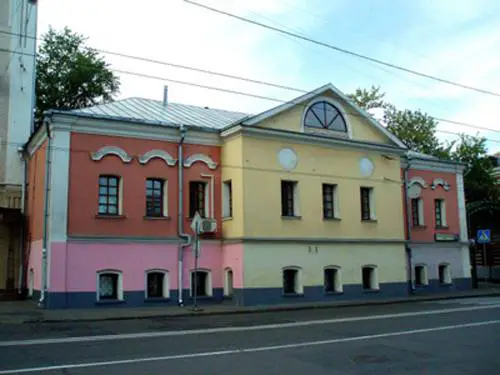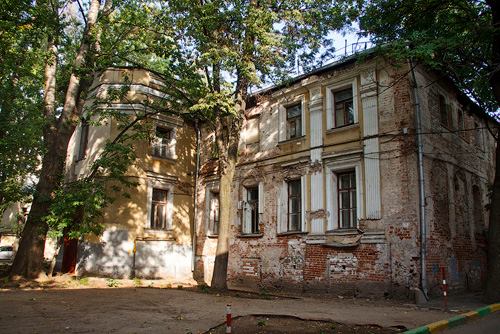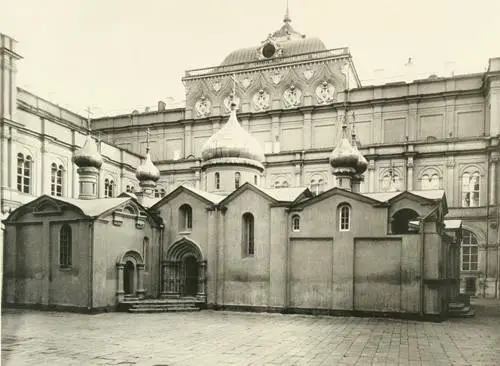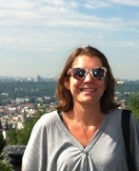The following information was taken from a Facebook post by Москва и Москвичи. It has been translated here by SRAS Home and Abroad Scholar Caroline Barlow. Some explanatory text (in italics) and hyperlinks to further information have also been included for those readers who are not well versed in the history of Moscow and Russia. Buildings are given in various categories with accompanying pictures and dates.
Moscow’s Oldest Building:
Andronikov Monastery of the Savior
Construction Dates: 1420-1425

This is also Moscow’s oldest church. It almost was not built, which would have made the Kremlin wall, built at the end of the fifteenth century, Moscow’s oldest building. According to historical records, the monastery was founded in 1357. After a fire in 1368, which burned down the original wooden cathedral, it was rebuilt using stone from the Savior’s Cathedral. Between 1420 and 1425, the Savior’s Cathedral was once more rebuilt, and this church has been preserved to this time. Andrey Rublev and Danil Chernii contributed frescos to the church, which are still preserved around the windows.
Moscow’s Oldest Civil Building:
The Chamber of Facets
Construction Dates: 1487-1491

(“Civil Building” or “Гражданское здание” in Russian, refers to a non-industrial, non-governmental building. These can include civic buildings, residential buildings, and commercial buildings.)
Ivan III ordered Italians Marco Ruffo and Pietro Antonio Solari to lead the construction. The name is taken from the Eastern façade, finished with faceted, rusticated, diamond-pointed stone, a style loved by architects of the Italian Renaissance. It was earlier named “The Grand Chamber,” and it was a front reception room for the palace. Here, the first meetings of the Boyar Duma and the Zemsky Sobor (the first Russian parliament of the feudal estates) were held.
Also, it was here that official celebrations were held after the conquest of Kazan in 1552, the victory over Poltova (now part of Ukraine, the battle was fought between Russia and Sweden as part of the Great Northern War) in 1709, and the end of the war with Sweden in 1721. Here, in 1653, the Zemsky Sobor made the decision to reunite Ukraine with Russia. For the Tsarina and their children, the architects built a secret booth . Built opposite the Tsar’s thrown, the Tsarina and kids were able watch the magnificent ceremonies and receptions for foreign dignitaries through a gate. Today, the hall functions as a hall at the palace of the Presidential Palace of the Russian Federation. Interestingly, the secret booth still stands.
The Oldest Civil Building Outside the Kremlin:
The English Court in Zaryadye
Construction Dates: End of the 15th Century – Beginning of the 16th Century

Originally, when the chamber appeared in the 15th century, it belonged to Ivan Bobrishev, who served as Gentleman of the Bedchamber (a member of the court in charge of the royal bed). Since he left no heir, the building was abandoned and repossessed by the government. In 1553, Sir Richard Chancellor opened a northern shipping route, connecting England to Russia. Ivan the Terrible, in the interests of strengthening commercial ties with Europe, gave the English several benefits: the right to trade freely and without duties in all Russian cities, as well as significant customs benefits, and a number of other trade privileges. In response to this, the Moscovy Company was founded in London in 1555
The house on Zaryadye was given to them to house the Moscow bureau of these British merchants.
Trade relations were severed between the two nations in 1649, as the execution of King Charles I led to a deep diplomatic crisis between the two countries. British representatives were expelled from Russia and the property of the Moscovy Company was confiscated.
It changed hands so many times in the following centuries that it became unrecognizable. By the mid-20th century, the building had completely lost its original appearance. By the mid-1960s, when most of the Zaryadye region had already been demolished (the massive Hotel Rossiya was built in its place), the renovator Peter Baranovski had determined what changes had been made to the original building and campaigned hard to preserve it, as it had been suggested to build a car ramp (for the hotel) in its place. Thanks to his efforts, the chamber was restored in 1972 to its 16th-century appearance (with close approximation).
The Oldest Civil Building Outside of The Earthen Works City:
The En-route Palace of Vasiliy III
Construction Dates: End of the 15th Century

(The “Earthen Works City” was Moscow’s third major expansion and was named for the earthern ramparts that originally surrounded and protected it. An “En-route Palace” was a palace used by the Russian nobility for temporary stays, often to rest while traveling to another location.)
The Traveling Palace of the Grand Prince of Moscow Vasili III, Ivan the Terrible’s father, is found at 15 Old Basman street. It’s discovery was a major find, as it was previously thought that nothing of this palace still existed. This modest mansion was discovered as The Golistyn Estate was being restored, making this project really “two in one.” The restoration revealed that the building had been used as a starting point for the construction of The Golitsyn Estate in the 18th century – The En-route Palace was located inside. The layout of the palace has remained almost completely unchanged! Historians have explained that this palace was founded on a special place – the location where, in 1935 the Vladimir Mother of God icon was found. According to legend, this icon had saved Russia from the invasion of Tamerlane.
The Oldest Building to Survive as a Residence:
The Golitsyn Chamber
Construction Dates: Second Half of the 18th Century

Found at 10 Krivokoleniy Lane, the Golitsyn Chamber is Moscow’s oldest building that is still in private use. The chamber is made up of three stone buildings: one main building with two long wings off to the sides. Parts of the building were built as early as the late 17th and early 18th century. It was earlier thought that only the first floor of the building was built in its early years, but a few years ago restorers found that the second and even third floors were also built in the 17th century. People still live in this house to this day. In the courtyard adjacent to the house, there is a beautiful garden with hammocks and tables.
The Oldest 5-storey Building:
The “Malter” of the Simonov Monastery
Construction Dates: 16th-17th Century

The height of this building is really impressive, because it shows that there was 5-storey building in the 16-17th centuries! This building had four stories and a loft on the 5th floor. According to the surviving documents, this building was intended to store food for the monks.
Moscow’s Oldest Building in a Photograph:
The Cathedral of the Savior on the Pines
Construction Date: 1328

The Cathedral of the Transfiguration on Bor was a monastery cathedral, located in the Kremlin, in the courtyard of the Grand Kremlin Palace. The name, “The Cathedral of the Savior on the Pines” (in Russian: собор Спаса на Бору) was taken from the coniferous forests that had surrounded the church. In 1933, the building was demolished and the church bells were given to the Moscow Kremlin collections.






